Research on Calculation Methods of Hydrodynamic Coefficients for Sections with Complex Shape
GAO Ni,SUN Shu-zheng,ZHAO Xiao-dong,LI Ji-de
(College of Shipbuilding Engineering,Harbin Engineering University,Harbin 150001,China)
1 Introduction
Calculating hydrodynamics is the base of the motion prediction of ships,and a large number of research based on potential theory have been done for a long time,also there are several engineering methods and theory for hydrodynamic coefficients calculation such as source/dipole mixed-distribution approach,multipole expansion approach,2.5D potential theory,3-D potential theory,and so on[1-3].The methods above can meet the engineering precision about the regular ship.But as the developing of the new type of ship,many irregular ships appear,like high performance monohulls and multi-hulled ships with various kinds of appendage.Because viscous damp takes large proportion in the hydrodynamic force,the calculation of hydrodynamic coefficients should be more accurate.The potential flow solver can not take viscous effect into account,as the developing of computer technology and CFD technology in recent years the RANS method accounting viscous effect has been used widely in ships’performance computation[4-5].
In this paper,the source/dipole mixed-distribution approach and 2D RANS method were used for computing the hydrodynamic coefficients of sections with and without SSB(Semisubmerged Bow)[6].The results computing by potential theory are compared to the result using viscous method,then the advantage and disadvantage are discussed between these methods.This paper shows that the viscous damp is considered by RANS method.The precision of calculation is higher with obvious viscous effect,but the advantage is little of the normal type of ships because the viscous effect is also little.Anyway this paper advances a new way to compute the hydrodynamics and improves the precision of viscous damp coefficient.
2 Calculating of 2D sections’hydrodynamic coefficients
2.1 Source/dipole mixed-distribution approach
Source/dipole mixed-distribution approach is suitable to special section such as catamaran,SWATH,underwater vehicle,and so on.Fig.1 shows the coordinates for the 2D section’s surge.
The 2D frequency domain Green function is introduced to solve the problem of 2D section surging.
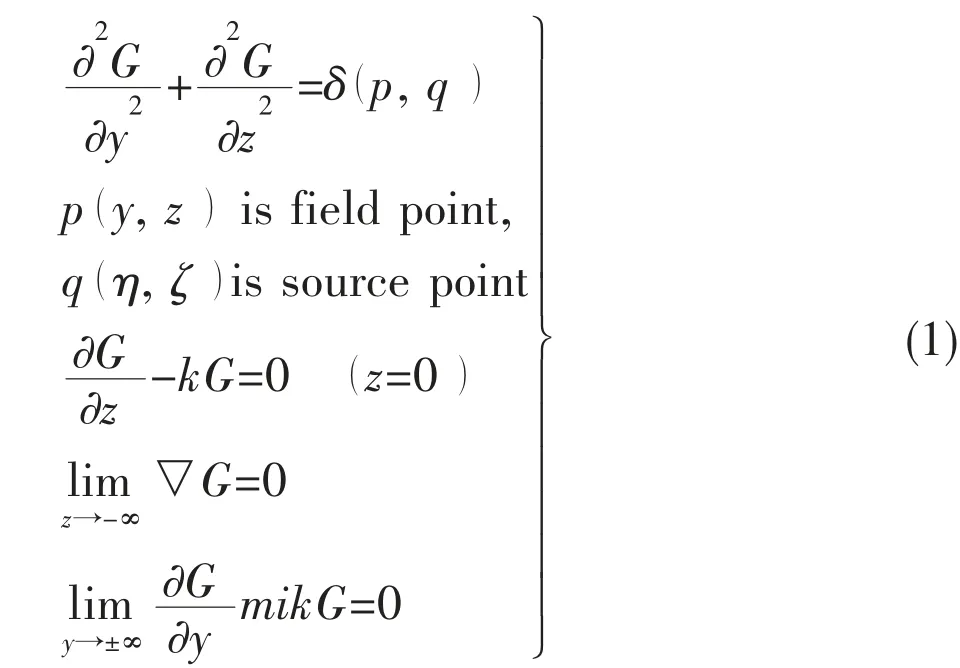

The 2-D frequency domain Green function could be written as:

where rpq=[(y- η)2+(z-ζ)2]1/2,rpq=[(y- η)2+(z+ζ)2]1/2
The velocity potential of any point p in the flow field could be expressed as below:

The line c presents the boundary of flow field with the normal direction pointing outside the flow field,and the direction is shown as Fig.1.
The additional mass of section mkjand damping coefficientμkjcan be obtained from the following equation:

2.2 RANS methods
2.2.1 Establishment of governing equation
Reynolds-averaged Navier-Stokes equations should be expressed as below:

Momentum equation should be expressed as below:

where uiis the time average velocity component(u1=u,u2=v,u3=w)for Cartesian coordinates xi(i=1,2, 3)direction,ρis fluid density,p is time average pressure,μis viscous coefficient,fiis the component of surface body force in xidirection which can be put into pressure item if body force only contains the gravity,ui′is the fluctuation velocity component of xi(i=1,2, 3)direction in Cartesian coordinates,andis Reynolds stress tensor.
Turbulent tension is proportional to average velocity and could be expressed as below:

whereμtis turbulence force viscous coefficient and can be expressed as below:

where,k,εare turbulence energy and turbulence energy dissipation respectively,and can be computed from the following equation:

where Pkis the producer of turbulence energy,and

Empirical constants Cμ=0.09,Cε1=1.44,Cε2=1.92,σk=1.0 andσε=1.30.The unknown quantities u,v,w,p,k andεcan be computed from the six closed equations above.
2.2.2 Calculation of 2D section surging
The ships calculated in this paper are the hybrid mono-hull with stabilizing appendage and the mono-hull with deep-V sections,and the sections are shown in Fig.2.

In this paper,the hydrodynamic coefficients of the bow were calculated using RANS method.The unsteady force was calculated by Fluent when section is surging slightly.The flow field,the mesh and the free surface are shown in Fig.3.The flow field of the computing model is discrete with FVM.The size of flow field is 10 times breadth×10 times draft;The mesh size is 0.1m on the section of the ship,while the mesh of the flow field is triangle unstructured and intensive beside the ship about 6 times breadth and 4 times draft.The flow field is divided into air part and water part,and the VOF method is used for free surface;The PISO arithmetic is employed and the turbulent flow model is RNG-κ-ε,also the dynamic meshing technique is used.The result of swaying force of deep-V section,section with SSB and section with SSB and fin whileω=2πis shown in Fig.4.
The added mass and damp coefficient of heaving could be got by vertical force computing,and the principle is below:the heaving additional mass isλ33,the heaving damp coefficient isμ33,the heaving displacement is Z,the heaving velocity is,the heaving acceleration is,the heaving amplitude is A,for the satisfaction of linear theory in this paper A is set as 0.02m,the initial phase isθ0,the radiation force is Fz,the restoring force is Fs,the vertical unsteady force is F=Fz+Fsand the amplitude of vertical unsteady force is Fa.

The vertical unsteady force F could be computed by Fluent,after discretization it can be expressed as below:
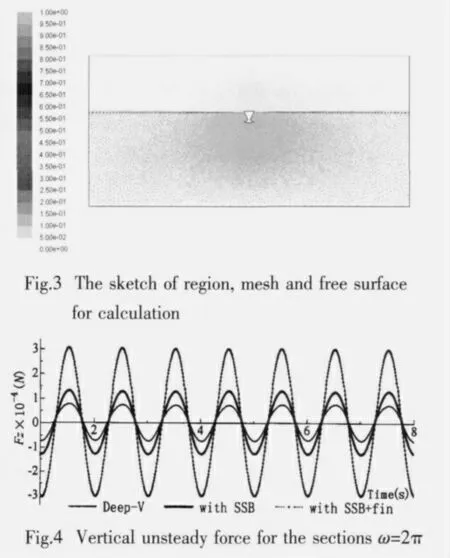

where B is the waterline breadth,A is the heaving amplitude,Fais the heaving force amplitude,θ0is the initial phase.ρ,g,B,A andωis known.The heaving additional massλ33and damp coefficientμ33could be got when Faandθ0are computed from the vertical unsteady force F.
2.3 Calculating results of hydrodynamic coefficients
Use the above method we can get the added mass and damping coefficient of the section,and the calculating results of sections with and without SSB are shown in Figs.5-10.
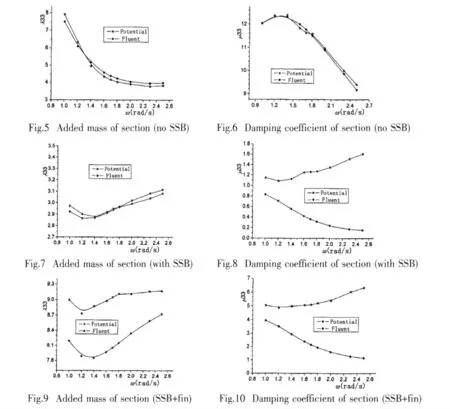
The calculation results show that viscous damp takes a small proportion of pitching damp in deep-V section without SSB,and the result calculated by Fluent is almost the same to the hydrodynamic coefficients by source/dipole mixed-distribution approach.The viscous damp takes a large proportion in section with SSB,consequently the result calculated by Fluent is more accurate than the one by potential flow theory.
3 The results of motion prediction
The prediction model used in this paper is STF method,which is useful for ship’s longitudinal motion prediction.The viscous modification hydrodynamic coefficient is the hydrodynamics by Fluent subtracting the hydrodynamics by potential theory,and the vertical equation of motion could be expressed as follows:

where the factor with*is viscous correction hydrodynamic coefficients.One of the two ships which were predicted in this paper is a deep-V monohull,the other is a hybrid monohull with SSB and fins.And the two ships are both about 1 200 tons weight,84 meters length and 10 meters breadth.The longitudinal prediction results of hybrid monohull with SSB and fins in head waves(Fr=0.32,0.43)are shown in Fig.11,and the longitudinal prediction results of deep-V monohull without SSB in head waves(Fr=0.32,0.43)are shown in Fig12.
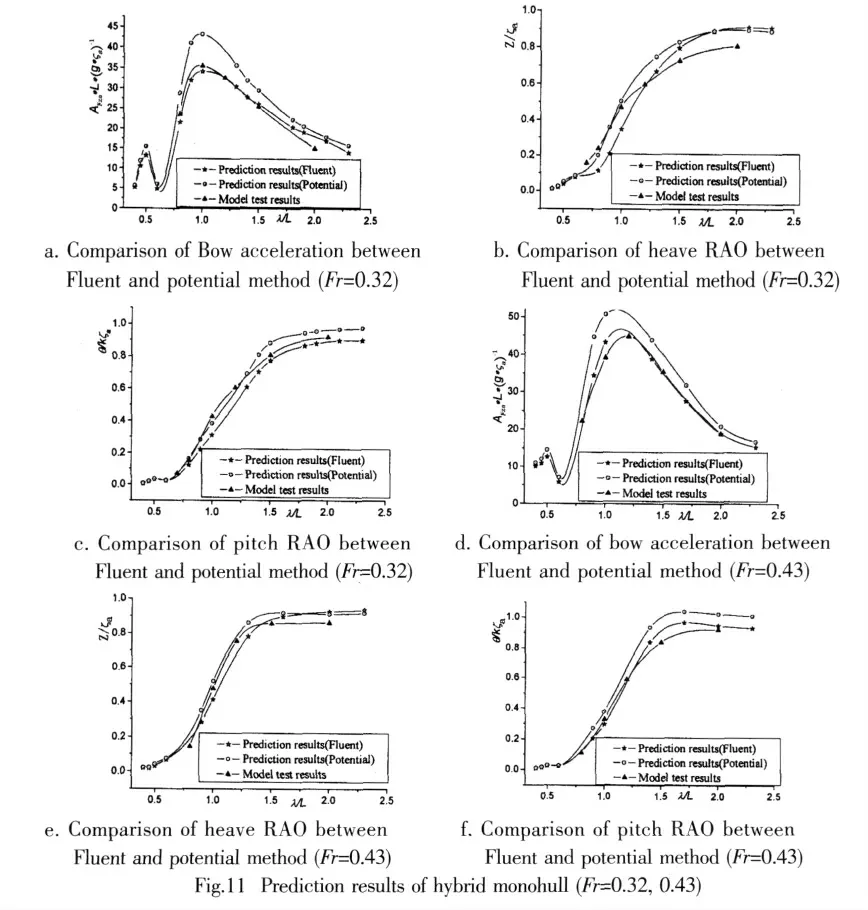
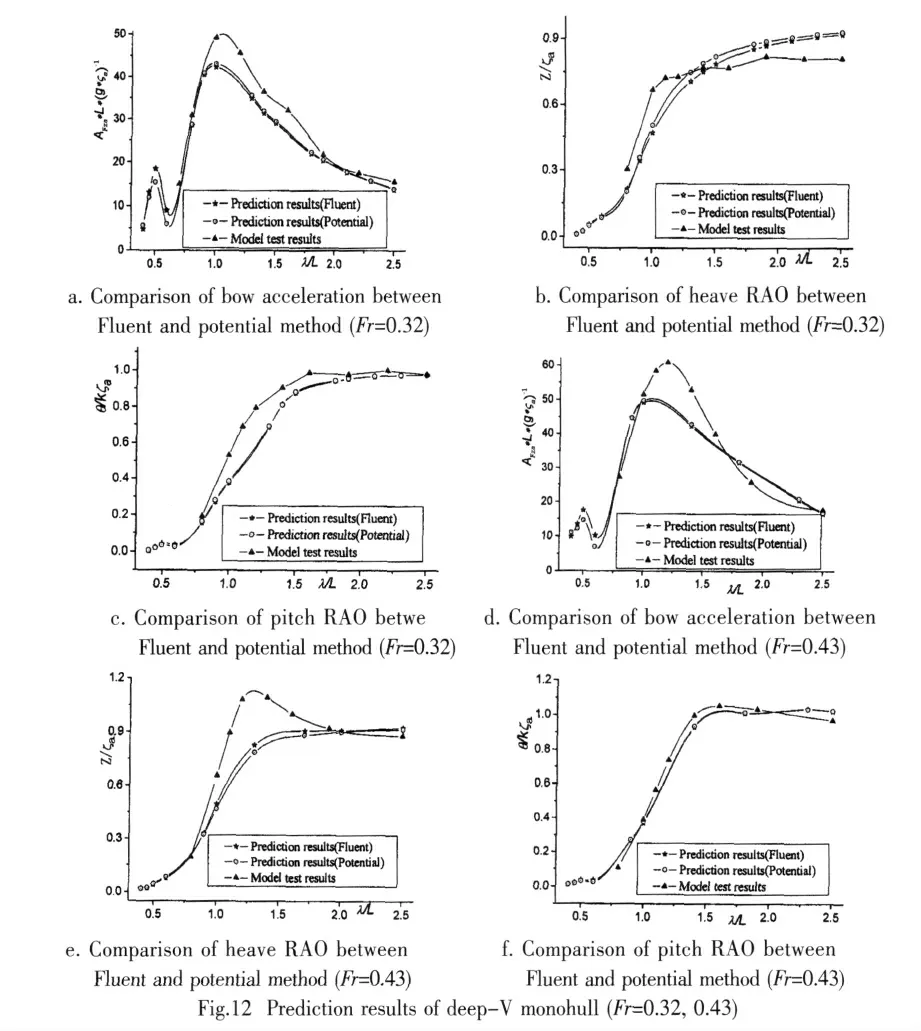
The comparison between the two calculation methods and model test results indicates that,for hybrid monohull the predicted results with viscous modification are better than potential method,while for deep-V monohull the predicted results with viscous modification are almost the same to potential method.
4 Conclusions
From the research of this paper we can obtain the following conclusions:
(1)From the comparison of hydrodynamic coefficients calculation results we can see that,the viscous damp takes a small proportion of pitching damp in deep-V section without SSB,and the result calculated by Fluent is almost the same to the hydrodynamic coefficients by source/dipole mixed-distribution approach.However,the viscous damp takes a large proportion in section with SSB and fin,consequently the result calculated by Fluent is more accurate than the one by potential flow theory.
(2)From the comparison of prediction results and model test results we can see that,for deep-V monohull the prediction results of viscous modification method is almost the same to potential theory,and for hybrid monohull with SSB and fin the prediction results of viscous modification method are better than potential theory.
All in all,the method used in this paper with viscous modification is a good way for hydrodynamics calculation especially for sections with complex shape wetted surface.
[1]Li Jide.Seakeeping performance of ships[M].Beijing:National Defense Industry Press,1992.
[2]Dai Yishan.Potential flow theory of ship motion in waves in frequency and time domain[M].Beijing:National Defense Industry Press,1998.
[3]Liu Yadong,Li Jide,Li Zhen.The simulation system design of 3-D panorama of ship motion in wave[J].Journal of Marine Science and Application,2002,1(2):6-11.
[4]Cai Xingong,Li Jide,Liu Yadong,Wang Jianfang.Prediction of motion of ships with built up stabilizing appendage[J].Journal of Hydrodynamics,2003,18(2):148-155.
[5]Li Jide,Zhang Heng.Motion prediction of hybrid monohull considering viscous effect[J].Journal of Ship Mechanics,2008,12(2):180-187.
[6]Sun Shuzheng,Li Jide,Zhao Xiaodong.Motion prediction of hybrid monohull considering viscous and bow up state effect[J].Journal of Ship Mechanics,2009,13(2):177-183.
- 船舶力学的其它文章
- Experimental Study on Resistance and Longitudinal Motion of High-speed Air Cavity Craft in Regular Waves
- Numerical Simulation of Pressure Distribution in Vertical Water-entry Cavity
- Study of a Hybrid Method Based on FDM and MLSFD Method
- Parametric Identification of AUV’s Maneuvering Motion Based on Support Vector Machines
- Investigation of Sea Wave and Structure Modelling for Fatigue Assessment of Offshore Structures

